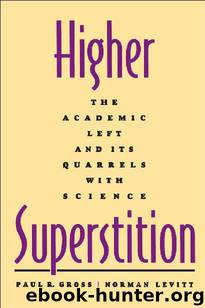Higher Superstition: The Academic Left and Its Quarrels with Science by Paul R. Gross & Norman Levitt

Author:Paul R. Gross & Norman Levitt [Gross, Paul R.]
Language: eng
Format: epub
Publisher: Johns Hopkins University Press
Published: 1997-12-21T04:30:00+00:00
In science, this happens all the time. Hypotheses generated by a small amount of preliminary evidence frequently collapse when the studies become larger, more systematic, and better controlled. In such cases, however, the initial finding is usually welcomed by ecoradicals for its doom-laden implications, while the later and better finding is systematically ignored. To such people, dioxin will always be a particularly horrific demon; Vietnam vets who are afflicted by disease will always be victims of Agent Orange; apples will remain suspect unless grown by naturists having no truck with chemicals: anything but “organic” produce will be suspect at best. Science can indict, but it is never allowed to dismiss the charges.
Naively, one would think that environmentalists should welcome news that the planet is, in some respects, not in quite as much danger as we might have thought. This neglects, however, to allow for the psychodynamics of an apocalyptic vision. Radical environmentalists scan the news pages and the popular science journals eagerly for every scrap of evidence that the ecological End of Days is upon us. As with biblical millenarians, objections of logic and fact have little effect. They are already convinced that the world is in calamitous decline. They believe, and seem to enjoy believing, that nature is being violated—blasphemously—by their neighbors, and that ultimate retribution is on the way. Evidence to the contrary is viewed as a terrible letdown, not as a reprieve.
Similarly, inasmuch as ecoradicalism is a movement with a worshipful view of the primal, it takes little heed of sober findings that, in many cases, uncorrupted, nonwhite, primitive peoples have been just as contemptuous of what we call environmental values as are greedy Euro-American industrialists. As the geographer Martin Lewis notes in Green Delusions, “a large proportion of eco-radicals fervently believes that human social and ecological problems could be solved if only we would return to a primal way of life. Ultimately, this proves to be an article of faith that receives little support from the historical and anthropological record.”30
The Indians of the Americas, for instance, are regularly depicted as paragons of ecological wisdom, at one with nature and the land. This not only collapses a vast and diverse array of cultures into a single “Native American” way of life, but, as well, neglects the fact that long before the hated Europeans made their way across the Atlantic, the earlier settlers, whose forebears came across the Arctic land bridge, wrought enormous—in some cases horrifying—changes to the biological landscape of the primeval Americas. For example, it is likely that most large North American mammals died out at the end of the last ice age because they were hunted to extinction by human newcomers: and there was as yet no population explosion! The Anasazi people of the Southwest turned their homeland into a treeless, eroded waste by their heedless use of timber. Mayan civilization may have collapsed because warfare, urbanization, and overpopulation depleted the fertility of its agricultural system. Slash-and-burn agriculture turned much of the Midwest from forest
Download
This site does not store any files on its server. We only index and link to content provided by other sites. Please contact the content providers to delete copyright contents if any and email us, we'll remove relevant links or contents immediately.
Enlightenment Now: The Case for Reason, Science, Humanism, and Progress by Steven Pinker(7273)
A Journey Through Charms and Defence Against the Dark Arts (Harry Potter: A Journey Through…) by Pottermore Publishing(4789)
The Immortal Life of Henrietta Lacks by Rebecca Skloot(4550)
A Journey Through Divination and Astronomy by Publishing Pottermore(4363)
Elon Musk by Ashlee Vance(4084)
Origin Story: A Big History of Everything by David Christian(3666)
COSMOS by Carl Sagan(3589)
Alchemy and Alchemists by C. J. S. Thompson(3481)
Bad Pharma by Ben Goldacre(3397)
Enlightenment Now by Steven Pinker(3352)
Shadow of Night by Deborah Harkness(3326)
Inferior by Angela Saini(3294)
A Mind For Numbers: How to Excel at Math and Science (Even If You Flunked Algebra) by Barbara Oakley(3256)
Origin Story by David Christian(3170)
The Code Book by Simon Singh(3138)
Signature in the Cell: DNA and the Evidence for Intelligent Design by Stephen C. Meyer(3098)
The Elements by Theodore Gray(3026)
A Brief History of Time by Stephen Hawking(2992)
A Journey Through Potions and Herbology (A Journey Through…) by Pottermore Publishing(2838)
